Association and path analysis of yield and yield attributing traits in sesame (Sesamum indicum L.)
Bạn đang xem bản rút gọn của tài liệu. Xem và tải ngay bản đầy đủ của tài liệu tại đây (585.87 KB, 8 trang )
Int.J.Curr.Microbiol.App.Sci (2018) 7(7): 4041-4048
International Journal of Current Microbiology and Applied Sciences
ISSN: 2319-7706 Volume 7 Number 07 (2018)
Journal homepage:
Original Research Article
/>
Association and Path Analysis of Yield and Yield Attributing
Traits in Sesame (Sesamum indicum L.)
Bhagwat Singh* and Rjani Bisen
Project Co-ordinating Unit (Sesame and Niger), JNKVV, Jabalpur (M.P.), India
*Corresponding author
ABSTRACT
Keywords
Wheat, Correlation
coefficient, Path
analysis, Direct
effect
Article Info
Accepted:
28 June 2018
Available Online:
10 July 2018
Correlation and path coefficient analysis were carried out for yield and yield attributing
traits in 60 genotypes of sesame during 2018. The genotypic correlation coefficients were
found to be of relatively higher magnitude than phenotypic correlation coefficient,
indicating strong inherent correlation between traits. The seed yield/plant exhibited
positive and significant correlation with days to flower initiation, days to 50% flowering,
number of primary branches per plant, number of secondary branches per plant and
number of capsules per plant both at genotypic and phenotypic levels. Path analysis
revealed that, days to flower initiation and number of capsules per plant exhibited highest
direct effect on seed yield per plant. This suggests that selection for this component
characters can help in improvement of seed yield in sesame.
Introduction
Sesame (Sesamum indicum L.) is an annual
plant that belongs to the Pedaliaceae family. It
is an erect herbaceous annual plant with either
single stemmed or branched growth habits and
two growth characteristics of indeterminate
and determinate, reaching up to 2 m height
and with a large tap root of 90 cm (Pham et at,
2010). Most of the sesame seeds which are
rich in fat protein, carbohydrates, fibre and
some minerals are used for oil extraction and
the rest are used for edible purposes (El Khier
et at, 2008). Among the different varieties of
sesame Sesamum indicum is the most usually
cultivated variety all over the world. Sesame
which is grown for its seeds contains about
50-60% oil content is also rich in fat, protein,
carbohydrates, fibre and some minerals
(Caliskan et ah, 2004).
India holds a premier position in the global
oilseeds scenario accounting for 29 per cent of
the total area and 26 per cent of production.In
India, sesame is cultivated in 17.138 lakh
hectare with a production of 7.84 lakh tonnes
and productivity of 457 kg /ha. Madhya
Pradesh contributes 19.71% and 23.68% share
of country’s area (3.80 lakh ha) and
production (1.94 lakh tonnes), respectively
with productivity of 511 Kg/ha (DACNET
2016-17).
4041
Int.J.Curr.Microbiol.App.Sci (2018) 7(7): 4041-4048
Correlation analysis is a statistical measure
used to measure the degree and direction of
relationship between two or more variables.
Most of the characters of interest to breeders
are complex and are the result of the
interaction of a number of components.
Understanding the relationship between yield
and its components is of paramount
importance for making the best use of these
relationships
in
selection.
Character
association
derived
by
correlation
coefficient,forms the basis for selecting the
desirable plant, aiding in evaluation of relative
influence of various component characters on
seed yield.
The path coefficient analysis is simply a
standardized partial regression coefficient
which splits the correlation coefficient into the
measure of direct and indirect effects. The
concept of path coefficient was developed by
Wright (1921). Path coefficient analysis was
applied for assessment by Dewey and Lu
(1959) in crested wheat grass.
The path analysis unravels whether the
association of independent characters with
dependent variable is due to their direct effect
on it or is a consequence of their indirect
effect via some other traits. If the correlation
between dependent and independent variables
is due to their direct effects of the character, it
reflects a true relationship between them and
selection can be practiced for such character in
order to improve the dependent variable. But,
if the association is mainly through indirect
effect of the character via another component
character, then the breeder has to select for the
latter through which the indirect effect is
exerted.
Materials and Methods
The present investigation will be conducted
during Summer 2018 under Project
Coordinating Unit (Sesame and Niger)
Research Farm, JNKVV, Jabalpur in
Randomized Complete Block Design with
three replications. The experimental material
consisted
of
60
sesame
genotypes.
Observations were recorded on five randomly
selected competitive plants for yield and yield
attributing traits.
Statistical analysis
Correlation coefficient
The Correlation coefficients were calculated
to determine the degree of association of the
characters with yield and also among the
different yield attributing traits. Phenotypic
coefficient of correlation between all pairs of
characters was determined by using variance
and covariance components as suggested by
Al-Jibouri at al. (1958). The analysis was done
using the Window-stat computer programme.
Path coefficient analysis
Path coefficient analysis was done using the
correlation coefficients to ascertain the direct
and indirect effects of the yield components
on yield as suggested by Wright (1921) and
illustrated by Dewey and Lu (1959). The
analysis was done using the Window-stat
computer programme.
Results and Discussion
Correlation coefficient among yield and
yield attributing traits
Correlation coefficient helps the breeder in
determining relative importance of yield
components for indirect selection for yield.
Understanding the relationships among yield
and yield components is of Paramount
importance for making the best use of these
relationships In selection. Results indicates
that higher values of genotypic correlation
coefficients than corresponding phenotypic
4042
Int.J.Curr.Microbiol.App.Sci (2018) 7(7): 4041-4048
correlation coefficients indicating a low
Influence of environmental factors.
Days to flower initiation showed highly
significant positive association with days to
50% flowering (0.9866) and seed yield per
plant (0.1947) and significant positively
associated with number of capsule per plant
(0.1786), days to 50% flowering showed
highly significant positive association with
seed yield per plant (0.2109) and number of
capsule per plant (0.1981), plant height
showed highly significant negative association
with 1000 seed weight (-0.2325), number of
primary branches per plant showed highly
significant positive association with seed yield
per plant (0.2085) and number of capsule per
plant (0.2112), number of secondary branches
per plant showed significant positive
association with seed oil content (0.1801),
number of capsule per plant (0.1666), number
of capsule per plant showed highly significant
positive association with seed yield per plant
(0.9102), number of seed per capsule showed
highly significant positive association with oil
content (0.1969) and significant negatively
associated with seed yield per plant (-0.1586)
and 1000 seed weight significant positively
associated with oil content (0.1858).
Indicating that these characters can be
considered for selection for higher yield, as
these were mutually and directly associated
with grain yield/plant.
Path coefficient analysis of different traits
contributing towards seed yield per plant
showed that days to flower initiation (2.618)
had highest positive direct effect followed by
number of capsule per plant (0.807), plant
height (0.308), oil content (0.279), capsule
length (0.273), harvest index (0.224), and
number of secondary branches per plant
(0.131), however, days to 50% flowering (2.326), number of seed per capsule (-0.359)
and number of primary branches per plant (0.235) exhibited negative direct effect. All
other direct effect was of mostly negative and
low in magnitude. Days to flower initiation
had maximum positive indirect effect on seed
yield per plant through days to 50% flowering
(2.604) followed by number of capsule per
plant (0.832) and number of primary branches
per plant (0.542), While, it had negative
indirect effect on seed yield per plant via plant
height (-1.029), harvest index (-0.514), 1000
seed weight (-0.346), capsule length (-0.323)
and number of secondary branches per plant (0.289). Days to 50% flowering had maximum
positive indirect effect on seed yield per plant
through plant height (1.013) followed by
harvest index (0.439), number of secondary
branches per plant (0.267), number of seed per
capsule (0.266), 1000 seed weight (0.259) and
capsule length (0.237), While, it had negative
indirect effect on seed yield per plant via days
to flower initiation (-2.314), number of
capsule per plant (-0.843) and number of
primary branches per plant (-0.420). Plant
height had maximum positive indirect effect
on seed yield per plant through days to
maturity (0.151), While, it had negative
indirect effect on seed yield per plant via days
to 50% flowering (-0.134) and 1000 seed
weight (-0.131). Number of capsule/ plant had
maximum positive indirect effect on seed
yield per plant through days to 50% flowering
(0.293), days to flower initiation (0.257), 1000
seed weight (0.182), number of primary
branches per plant (0.178), number of
secondary branches per plant (0.133) and days
to maturity (0.112), While, it had negative
indirect effect on seed yield per plant via
number of seed per capsule (-0.215).
Considering the correlation coefficient and
path coefficient analysis for grain yield and
yield components, an ideal plant type in
sesame would be one with days to flower
initiation and number of capsules per plant.
Therefore, more emphasis should be given to
these components while making selection for
development of high yielding wheat varieties
in future.
4043
Int.J.Curr.Microbiol.App.Sci (2018) 7(7): 4041-4048
Table.1 List of genotypes used in study
S.No.
Genotypes
S.No.
Genotypes
1
RT-127
31
TMV-7
2
RT-346
32
THILAK
3
RT-103
33
PKV-NT-11
4
RT-54
34
YLM-17
5
RT-46
35
YLM-66
6
GT-1
36
THILARANI
7
GT-2
37
CO-1
8
TKG-306
38
RT-125
9
JTS-8
39
RT-351
10
TKG-55
40
GT-10
11
TKG-22
41
BRIJESHWARI
12
JLT-408
42
RAJESHWARI
13
MT-75
43
DSS-9
14
VRI-1
44
VINAYAK
15
VRI-2
45
TARUN
16
DS-5
46
KALIKA
17
PT-1
47
KRISHNA
18
N-32
48
HIMA
19
RAMA
49
THILATHARA
20
GT-4
50
N-8
21
T-4
51
DS-1
22
AKT-101
52
YLM-11
23
NIRMALA
53
SEKHAR
24
USHA
54
JLT-7
25
CHANDANA
55
PRACHI
26
SMARK
56
TMV-4
27
SAVITRI
57
KANAK
28
PKDS-8
58
SSD-5
29
PKDS-11
59
JT-12(PKDS-12)
30
SWETHA TILL-1
60
TKG-21
4044
Int.J.Curr.Microbiol.App.Sci (2018) 7(7): 4041-4048
Table.2 Phenotypic and Genotypic correlation analysis for yield and yield related traits in sesame
Character
Days to
flower
initiation
Days to 50%
flowering
Days to
maturity
Capsule
length (cm
Plant height
(cm
Number of
primary
branches per
plant
Number of
secondary
branches per
plant
Number of
capsule/ plant
number of
seed per
capsule
1000 seed
weight (g
Oil content
(%)
Harvest index
Seed yield
per plant
Days to
flower
initiation
G
P
G
P
G
P
G
P
G
P
G
P
Days to
50%
flowering
Days to
maturity
Capsule
length
(cm)
Plant
height
(cm)
0.9948
0.9866 ***
-0.039
0.0913
-0.1235
0.0249
-0.3931
-0.0877
0.0082
0.1109
-0.1018
0.0339
-0.1241
-0.0536
-0.4353
-0.0883
0.4904
0.0452
0.1397
-0.0295
Number of
primary
branches
per plant
0.207
0.0341
Number of
secondary
branches per
plant
-0.1104
-0.0751
0.1804
0.0238
-0.2485
-0.0387
0.0539
0.0317
0.1859
0.003
-0.1147
-0.0724
0.0028
-0.0106
0.1046
0.1239
-0.1322
-0.0364
0.0837
0.1406
G
P
G
P
G
P
G
P
G
P
G
P
G
P
4045
Number of number of 1000 seed
capsule/
seed per weight (g)
plant
capsule
Oil
content
(%)
Harvest
index
Seed yield
per plant
0.3178
0.1786 *
-0.0705
-0.102
-0.1322
-0.1112
-0.0209
-0.0827
-0.1964
0.0052
0.3208
0.1947 **
0.3626
0.1981 **
0.1387
-0.0422
0.0566
0.0324
-0.0874
-0.0505
0.2211
0.2112 **
-0.1143
-0.1152
-0.0181
-0.0269
0.3652
0.0923
-0.0809
-0.0591
-0.0978
-0.0658
-0.1111
-0.1139
-0.0904
-0.0989
-0.0795
-0.0441
-0.4249
-0.2325 **
-0.4493
-0.1403
0.0163
-0.0724
-0.1734
-0.0816
-0.1353
-0.0928
-0.2397
-0.1181
-0.0091
0.0471
-0.1889
0.0138
0.1505
-0.0279
-0.0041
-0.0266
-0.2686
0.018
0.0559
0.0316
0.3556
0.2109 **
0.1211
-0.0274
0.1118
0.0611
0.0852
0.0024
0.2073
0.2085 **
0.1642
0.1316
0.3406
0.1666 *
0.0177
-0.0039
0.244
0.1801 *
-0.053
-0.048
0.1427
0.1203
-0.2661
-0.1224
0.226
0.1302
0.0615
0.0032
0.0763
0.0709
0.3821
0.1969 **
0.2358
0.1168
-0.1102
-0.0471
0.916
0.9102 ***
-0.2684
-0.1586 *
0.3492
0.1858 *
-0.1301
-0.0211
-0.1657
-0.0837
0.0907
0.0566
0.0005
-0.0119
0.2244
0.1158
Int.J.Curr.Microbiol.App.Sci (2018) 7(7): 4041-4048
Table.3 Genotypic path coefficient analysis showing direct and indirect effects for yield and yield related traits in sesame
Character
Days to
flower
initiation
Days to
50%
Flowering
Days to
Maturity
Capsule
Length
(cm)
Plant
Height
(cm)
Number of
primary
branches
per plant
Number
of
secondary
branches
per plant
Number
of
capsule/
plant
number
of seed
per
capsule
1000
seed
weight
(g)
Oil
content
(%)
harvest
index
Days to flower initiation
2.618
2.604
-0.102
-0.323
-1.029
0.542
-0.289
0.832
-0.185
-0.346
-0.055
-0.514
Days to 50% flowering
-2.314
-2.326
-0.019
0.237
1.013
-0.420
0.267
-0.843
0.266
0.259
-0.038
0.439
Days to maturity
0.002
0.000
-0.038
0.005
-0.019
0.009
0.000
-0.005
0.001
0.003
0.007
-0.006
Capsule length (cm)
-0.034
-0.028
-0.034
0.273
0.038
0.015
0.029
0.015
0.100
-0.022
-0.037
-0.001
Plant height (cm)
-0.121
-0.134
0.151
0.043
0.308
0.057
-0.041
-0.027
-0.025
-0.131
-0.074
-0.083
Number of primary branches per plant
-0.049
-0.042
0.058
-0.013
-0.044
-0.235
-0.020
-0.052
0.023
0.106
0.002
-0.013
Number of secondary branches per plant
-0.014
-0.015
0.000
0.014
-0.017
0.011
0.131
0.021
0.045
0.002
0.032
-0.007
Number of capsule/ plant
0.257
0.293
0.112
0.046
-0.071
0.178
0.133
0.807
-0.215
0.182
0.062
0.190
number of seed per capsule
0.025
0.041
0.007
-0.131
0.029
0.035
-0.122
0.096
-0.359
-0.022
-0.137
0.040
1000 seed weight (g)
0.001
0.001
0.001
0.001
0.004
0.004
0.000
-0.002
-0.001
-0.009
-0.003
0.001
Oil content (%)
-0.006
0.005
-0.048
-0.038
-0.067
-0.003
0.068
0.021
0.107
0.098
0.279
-0.046
Harvest index
-0.044
-0.042
0.034
-0.001
-0.060
0.013
-0.012
0.053
-0.025
-0.029
-0.037
0.224
Seed yield per plant
0.321
0.356
0.121
0.112
0.085
0.207
0.143
0.916
-0.268
0.091
0.001
0.224
4046
Int.J.Curr.Microbiol.App.Sci (2018) 7(7): 4041-4048
Fig.1 Genotypic path for seed yield per plant
4047
Int.J.Curr.Microbiol.App.Sci (2018) 7(7): 4041-4048
References
Al-Jibouri H. A., Miller P. A. and Robinson
H. F. (1958). Genotypic and
environmental co-variances in an
upland cotton cross of inter specific
origin. Agron. J., 50:633-637.
Caliskan S, Arslan M, Arioglu and Isler N.
2004. Effect of planting method and
plant population on growth and yield
of sesame (Sesamum indicum L.) in a
Mediterranean type of environments.
Asian J. Plant Sci., 3:610-613.
DACNET 2016-17. 4th Advanced Estimation.
GOI.
Dewey DR and Lu KH. 1959. A correlation
and path coefficient analysis of
components of crested wheat grass
seed production. Agronomy Journal
51 (9): 515-518.
EL Khier MKS, Ishag KEA and Yagoub
AEA. 2008. Chemical composition
and oil characteristics of sesame seed
cultivars grown in Sudan. Res. J.
Agric. Biol. Sci., 4:761-766.
Pham TD, Nguyen T, Carlsson AS and Bui
TM. 2010. Morphological evaluation
of sesame (Sesamum indicum L.)
varieties from different origins. Aust.
J. Crop Sci., 4:498-504.
Wright S. 1921. Correlation and causation.
Journal of Agriculture Research 20 :
557-585.
How to cite this article:
Bhagwat Singh and Rjani Bisen. 2018. Association and Path Analysis of Yield and Yield
Attributing Traits in Sesame (Sesamum indicum L.). Int.J.Curr.Microbiol.App.Sci. 7(07): 40414048. doi: />
4048
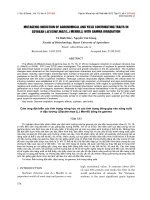
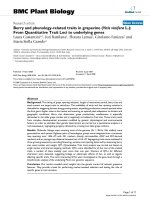
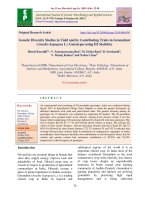
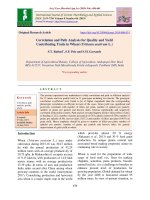

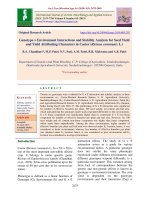

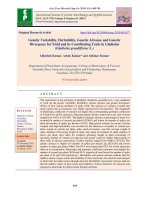
![Genetic variability studies in F2 segregating populations for yield and its component traits in Okra [Abelmoschu sesculentus (L.)Moench]](https://media.store123doc.com/images/document/2020_01/13/medium_nxs1578931693.jpg)
